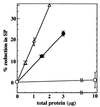Spore photoproduct (SP) lyase from Bacillus subtilis specifically binds to and cleaves SP (5-thyminyl-5,6-dihydrothymine) but not cyclobutane pyrimidine dimers in UV-irradiated DNA
- PMID: 11053385
- PMCID: PMC94787
- DOI: 10.1128/JB.182.22.6412-6417.2000
Spore photoproduct (SP) lyase from Bacillus subtilis specifically binds to and cleaves SP (5-thyminyl-5,6-dihydrothymine) but not cyclobutane pyrimidine dimers in UV-irradiated DNA
Abstract
The predominant photolesion in the DNA of UV-irradiated dormant bacterial spores is the thymine dimer 5-thyminyl-5,6-dihydrothymine, commonly referred to as spore photoproduct (SP). A major determinant of SP repair during spore germination is its direct reversal by the enzyme SP lyase, encoded by the splB gene in Bacillus subtilis. SplB protein containing an N-terminal tag of six histidine residues [(6His)SplB] was purified from dormant B. subtilis spores and shown to efficiently cleave SP but not cyclobutane cis,syn thymine-thymine dimers in vitro. In contrast, SplB protein containing an N-terminal 10-histidine tag [(10His)SplB] purified from an Escherichia coli overexpression system was incompetent to cleave SP unless the 10-His tag was first removed by proteolysis at an engineered factor Xa site. To assay the parameters of binding of SplB protein to UV-damaged DNA, a 35-bp double-stranded oligonucleotide was constructed which carried a single pair of adjacent thymines on one strand. Irradiation of the oligonucleotide in aqueous solution or at 10% relative humidity resulted in formation of cyclobutane pyrimidine dimers (Py lozengePy) or SP, respectively. (10His)SplB was assayed for oligonucleotide binding using a DNase I protection assay. In the presence of (10His)SplB, the SP-containing oligonucleotide was selectively protected from DNase I digestion (half-life, >60 min), while the Py lozengePy-containing oligonucleotide and the unirradiated oligonucleotide were rapidly digested by DNase I (half-lives, 6 and 9 min, respectively). DNase I footprinting of (10His)SplB bound to the artificial substrate was carried out utilizing the (32)P end-labeled 35-bp oligonucleotide containing SP. DNase I footprinting showed that SplB protected at least a 9-bp region surrounding SP from digestion with DNase I with the exception of two DNase I-hypersensitive sites within the protected region. (10His)SplB also caused significant enhancement of DNase I digestion of the SP-containing oligonucleotide for at least a full helical turn 3' to the protected region. The data suggest that binding of SP lyase to SP causes significant bending or distortion of the DNA helix in the vicinity of the lesion.
Figures





Similar articles
-
Mechanistic studies of the radical SAM enzyme spore photoproduct lyase (SPL).Biochim Biophys Acta. 2012 Nov;1824(11):1264-77. doi: 10.1016/j.bbapap.2011.11.008. Epub 2011 Dec 8. Biochim Biophys Acta. 2012. PMID: 22197590 Free PMC article. Review.
-
The subunit structure and catalytic mechanism of the Bacillus subtilis DNA repair enzyme spore photoproduct lyase.Proc Natl Acad Sci U S A. 2001 Jul 31;98(16):9038-43. doi: 10.1073/pnas.161278998. Epub 2001 Jul 24. Proc Natl Acad Sci U S A. 2001. PMID: 11470912 Free PMC article.
-
Spore photoproduct lyase from Bacillus subtilis spores is a novel iron-sulfur DNA repair enzyme which shares features with proteins such as class III anaerobic ribonucleotide reductases and pyruvate-formate lyases.J Bacteriol. 1998 Sep;180(18):4879-85. doi: 10.1128/JB.180.18.4879-4885.1998. J Bacteriol. 1998. PMID: 9733691 Free PMC article.
-
Spore photoproduct within DNA is a surprisingly poor substrate for its designated repair enzyme-The spore photoproduct lyase.DNA Repair (Amst). 2017 May;53:31-42. doi: 10.1016/j.dnarep.2016.11.005. Epub 2017 Mar 6. DNA Repair (Amst). 2017. PMID: 28320593 Free PMC article.
-
Resistance of spores of Bacillus species to ultraviolet light.Environ Mol Mutagen. 2001;38(2-3):97-104. doi: 10.1002/em.1058. Environ Mol Mutagen. 2001. PMID: 11746741 Review.
Cited by
-
The enzyme-mediated direct reversal of a dithymine photoproduct in germinating endospores.Int J Mol Sci. 2013 Jun 25;14(7):13137-53. doi: 10.3390/ijms140713137. Int J Mol Sci. 2013. PMID: 23799365 Free PMC article.
-
Mechanistic studies of the radical SAM enzyme spore photoproduct lyase (SPL).Biochim Biophys Acta. 2012 Nov;1824(11):1264-77. doi: 10.1016/j.bbapap.2011.11.008. Epub 2011 Dec 8. Biochim Biophys Acta. 2012. PMID: 22197590 Free PMC article. Review.
-
Roles of small, acid-soluble spore proteins and core water content in survival of Bacillus subtilis spores exposed to environmental solar UV radiation.Appl Environ Microbiol. 2009 Aug;75(16):5202-8. doi: 10.1128/AEM.00789-09. Epub 2009 Jun 19. Appl Environ Microbiol. 2009. PMID: 19542328 Free PMC article.
-
The subunit structure and catalytic mechanism of the Bacillus subtilis DNA repair enzyme spore photoproduct lyase.Proc Natl Acad Sci U S A. 2001 Jul 31;98(16):9038-43. doi: 10.1073/pnas.161278998. Epub 2001 Jul 24. Proc Natl Acad Sci U S A. 2001. PMID: 11470912 Free PMC article.
-
Roles of the major, small, acid-soluble spore proteins and spore-specific and universal DNA repair mechanisms in resistance of Bacillus subtilis spores to ionizing radiation from X rays and high-energy charged-particle bombardment.J Bacteriol. 2008 Feb;190(3):1134-40. doi: 10.1128/JB.01644-07. Epub 2007 Nov 30. J Bacteriol. 2008. PMID: 18055591 Free PMC article.
References
-
- Donnellan J E, Jr, Setlow R B. Thymine photoproducts but not thymine dimers are found in ultraviolet irradiated bacterial spores. Science. 1965;149:308–310. - PubMed
-
- Friedberg E C, Walker G C, Siede W. DNA repair and mutagenesis. Washington, D.C.: ASM Press; 1995.
-
- Gross D S, English K E, Collins K W, Lee S. Genomic footprinting of the yeast HSP82 promoter reveals marked distortion of the DNA helix and constitutive occupancy of heat shock and TATA elements. J Mol Biol. 1990;216:611–632. - PubMed
Publication types
MeSH terms
Substances
Grants and funding
LinkOut - more resources
Full Text Sources
Molecular Biology Databases
Miscellaneous

